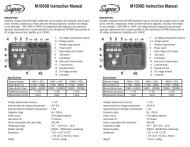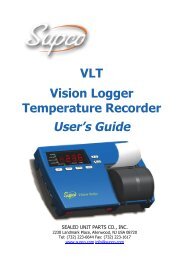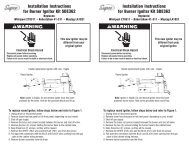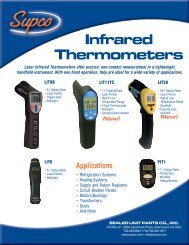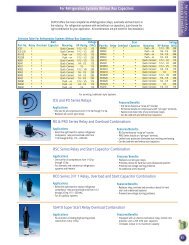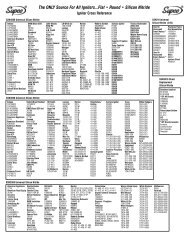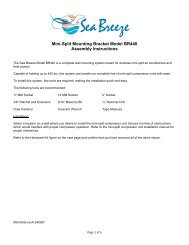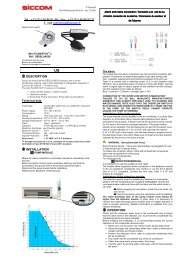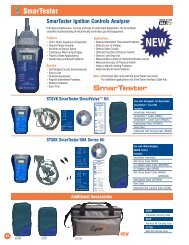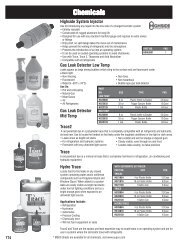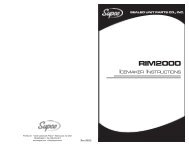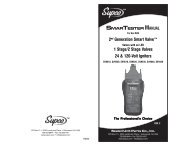THEORY AND FIELD PROBLEMS OF THE CAPILLARY ... - Supco
THEORY AND FIELD PROBLEMS OF THE CAPILLARY ... - Supco
THEORY AND FIELD PROBLEMS OF THE CAPILLARY ... - Supco
Create successful ePaper yourself
Turn your PDF publications into a flip-book with our unique Google optimized e-Paper software.
Notice how the sub cooling below its condensingtemperature makes a cap away from its condensingpressures. And it’s this gap which governs where thebubble point will occur.Notice the difference in two-phase lengths afterthe bubble point with 7°, 15°, and 20° sub cooling. Thedifferent bubble points are shown where the dotted linesmeet.It is most important to realize that as the loadingor ambients change, the degree of sub-cooling changes,as a result, the two-phase length also changes, whichgives you the necessary controlling factor of the totalrefrigerant flows.There is one interesting point I would like tobring out, and that is, when the condenser becomesoverloaded and the pressures go very high, you haveanother controlling factor. At this point of high loadingnot all the refrigerant is condensed and some vapors enterthe cap tube as gas pockets. These gas pockets furtherrestrict the refrigerant flow without affecting the headpressure.This is one advantage the cap tube system hasover the thermostatic expansion valve in preventing anoverload on the motor.To summarize on the theory of cap tubes althoughthe head pressures have a direct effect to the flow rate,it’s the changing two phase lengths that counters thisaction; to speed up the flow at low ambients, and act as abrake at high ambient. It is these minimum andmaximum flow rates that play an important factor whendesigning a cap tube system.SERVICE <strong>PROBLEMS</strong>The service problems of the cap tube itself arevery simple. It can only become restricted in variousdegrees; which brings us to the question “How can thecap tube become restricted if there is a strainer in front ofit”?There are two causes: 1) is factory made 2) iseither caused by a clogged condenser or a stuck fanmotor. There are times when a very small amount ofcontamination is left in the system after the unit leavesthe factory. It could be alkali or acidic, in either case,given enough time these chemicals react with therefrigerant and the variety of metals in the system to formmicroscopic particles as fine as talcum powder. Thesetiny particles can easily pass thru the finest screen or felt,in fact go right on thru the cap tube itself. However, whenthese particles cling to the inside wall of the tubing theyreduce the diameter and cause the restriction.The excessive head pressures and temperaturescaused by a clogged condenser or stalled fan motor willtend to break down the oil vapors. This condition willalso form microscopic particles and the results will be thesame.Although the service problems of the cap tubeitself are simple, it’s the entire system that more thanoften leads to complications that involve the customer,serviceman, service manager, the owner of the company,the factory sales manager, the president of the factory,even the better business bureau finds itself involved. Themany hours of aggravation on the phone and the threatsof attorneys by mail usually starts with what is seeminglya very minor service call: the evaporator is not fullyfrosted. All texts and service manuals describe this as avery simple problem and I quote “the underchargedevaporator can be caused by a slight shortage ofrefrigerant in the system or a slight restriction in the captube”. That is the same as a doctor diagnosing a patient’scomplaint of a stomach pain as either indigestion orcancer.Most servicemen are eternal optimists and justnever think of a restricted cap tube because of itscomplicated ramifications. Especially the highlyexperienced who know that a “shot of gas” will solve theproblem. I did say highly experienced not highly skilled.Of course there are many instances where there isa very slight leak in the system in the magnitude of a halfouncea year and in 4 or 5 years the system responds tothe shortage.In such cases it may be most practical to add somegas without subjecting the customer to the expense oflocating and repairing the leak.However, let us follow one of these servicemenon a job that has a restricted cap tube and see whatactually happens.SEALED UNIT PARTS CO., INC.P.O. Box 21, 2230 Landmark Place, Allenwood, N.J. 08720(732)223-6644 • Fax (732)223-1617www.supco.com • info@supco.com
Here we see a schematic of a domesticrefrigerator. Notice that the evaporator is undercharged;but not the system. The amount of refrigerant missingfrom the evaporator is now backed up and accumulated inthe condenser. You can also say that the system is out ofbalance; the new reduced flow rate, because of therestriction, cannot keep the evaporator in a floodedcondition and the volumetric capacity of the compressoris now greater than the flow rate.Now, if a serviceman were to install a low sidegauge he would get no more information than if he had athermo-couple attached to the freezing portion of theevaporator. However, if he also installed a high side gauge,he would notice the unbalanced condition.But our serviceman has no time for extensivediagnosing. He installs a low side-piercing valve, addssome gas and “presto” the entire evaporator is fullycharged and frosted. The customer compliments him forhis skill and technical efficiency while he quickly gathersup his tools and leaves.Let’s see what he accomplished.Here we see the same system as before, but nownot only are the evaporator fully charged we also have acondenser that is 1/3 filled with liquid. The head pressure isalmost 170 lbs. And it’s this excessive pressure that madethe serviceman look so successful. By overcharging thesystem and loading the condenser, he has reduced theeffective condensing area about 30% and increased thehead pressure to the flow rate of the cap tube and is able tomaintain the evaporator in a fully charged condition.If the original restriction caused an unbalancedcondition, the overcharge of refrigerant has nowcompounded the problem. First of all the excessive amountof refrigerant in the condenser would cause an extremedelay in equalizing after the system reached temperature. Ifthe thermostat cut-in during this delay the unit would cyclein locked rotor condition on the overload. Secondly whenthe system did equalize and the entire condenser emptiedinto the evaporator, the liquid would overflow and drain intothe suction line. The unit would start with a flooded suctionand operate on a high back and high head pressurecondition for a considerably long “on cycle”.During a hot spell the 170 lbs. Head pressure caneasily become 220 lbs. And cycling on overload andoperating in a constant high amperage condition willeventually burn out the unit.This is the final result of a wrong diagnosis of anundercharged evaporator, either by choice of just beingmisinformed. A shortage of refrigerant in the evaporator canbe very deceptive and to rely only on a low side gauge orelectrical instruments can only add to the deception if youare trying to diagnose the difference between a restrictedcap tube and slight refrigerant leak.One of the most reliable methods of solving thisproblem is to use a high side gauge, and many times theuse of your hands can confirm your findings. Unfortunately,the sealed system has given birth to a new breed ofserviceman; he only uses the “touch method”. Using a wetfinger on an evaporator, he can tell temperature; touchingthe dome, he knows the amperage its drawing; andtouching the condenser, he can sense the head pressure.The serviceman who uses his eyes, ears and handscan obtain a lot of useful information to aid him indiagnosing a defect, but they won’t tell you pounds persquare inch, and in a cap tube system its very important toknow the head pressure. Let me illustrate this by the nextdiagram.SEALED UNIT PARTS CO., INC.P.O. Box 21, 2230 Landmark Place, Allenwood, N.J. 08720(732)223-6644 • Fax (732)223-1617www.supco.com • info@supco.com
Notice that both evaporators are undercharged andboth low side gauges read the same but the head pressuresare different. Now, at an ambient of between 75° and 80° thehead pressure of a restricted cap tube system will alwaysread normal or slightly above normal, but the pressure of asystem short of refrigerant will always read lower thannormal. To confirm your diagnosis your hands can locate afew differences.The strainer on a restricted cap tube should be aboutroom temperature because of the sub cooled liquid that hasbacked up, and running your hand down slowly from the topof the condenser the temperature should e warm thensuddenly cool to room temperature to the level where theliquid refrigerant has backed up.In a system that is short of refrigerant the condenserwould have a gradual change in temperature from the top allthe way down to the strainer. In fact the strainer will beslightly above room temperature.Another method of diagnosing the difference is toeither blanket a static condenser or partially block a fancooled condenser, the increased head pressure will raise theliquid level of the evaporator in the restricted cap tube systembut if the system was short of gas there would be littlechange if any.But while your head gauge is connected the mostpositive check is to add a few ounces of refrigerant. Therestricted unit will show a sharp rise to an excessive headpressure and the strainer will still be at room temperature.Running our hand down from the top of the condenser youwill notice that the point of sudden cooling has risen to a newlevel.The unit that was short of refrigerant will show a slowrise in the head pressure to slightly above normal dependingupon how fast you are adding the gas; and the strainer willget hot.To summarize the differences between a restrictedcap tube and short of refrigerant, you might say that I haveoveremphasized and elaborated in the diagnosingprocedures, but don’t forget that we are dealing with thecomparison of indigestion and cancer. Whereas in ourextreme case, the system can be saved by changing the captube – a wrong diagnosis can kill the entire system.To those servicemen who insist on hot using a set ofgauges, the inefficient compressor is the “coup de gras”.However, the service engineer who uses gauges finds thatthe inefficient compressor becomes the easiest problem todiagnose.There are many degrees of inefficiency, so let us bemore specific and diagnose the most difficult of all; acompressor that has lost about 15% of its original capacity.The complaint on this type of system is that the unitruns continuously. In fact in many cases of this type thecomplaint is that the food freezes so the “touch method”serviceman adjusts the thermostat. This is as helpful astaking a few aspirins for a broken leg.They symptoms of an inefficient compressor wouldbe as follows: the evaporator would be flooded or fullyfrosted touching the condenser should give you theimpression that there isn’t much heat there and thetemperature would be almost the same to the strainer. Athermocouple near the thermostat feeler bulb should readabout 5 degrees above it’s cut out point. The suction lineshould be unusually cold.What you are actually witnessing is a state ofequilibrium. The entire load on the unit equals the capacity ofthe compressor. If the ambient temperature should rise theevaporator temperature would also rise. If the ambienttemperature should go low enough the unit may cycle.SEALED UNIT PARTS CO., INC.P.O. Box 21, 2230 Landmark Place, Allenwood, N.J. 08720(732)223-6644 • Fax (732)223-1617www.supco.com • info@supco.com
Installing a set of gauges should tell the story. Thebackpressure would be high and the head pressure lowerthan normal. The inefficient compressor is the onlycondition that gives you this type of pressure combinationso you cannot be mistaken.These are the same symptoms if you installed anoversized cap tube or an undersized compressor.Now as far as selecting cap tubes for replacementis concerned, the object is to duplicate the original flowrate and replacing the original length and bore would bethe easiest, but it’s never available when you need it.There are many companies who offerreplacements and we of sealed unit parts claim to havethe best. I only say this because it’s true.But no matter where you get the replacement, theuse of a set of gauges is very important.your hand down the condenser you will be able to judge wherethe liquid refrigerant is backed up to. Purging the excess offwill leave the evaporator short.The unit at the right has a cap tube that has too high aflow rate. Running this unit will show the same symptoms asan inefficient compressor. The backpressure remains highwhile the head pressure will be lost.Speaking about replacement cap tubes I must tell youabout my invention. I actually invented a cap tube andcompressor efficiency tester; it’s so revolutionary that I wasgranted a patent. There’s only one problem with the beast, wecant’ sell it. It’s so simple no one understands it.Let me show you how it works.Here are 3 schematics that may help you indetermining if you have the proper cap tube.At our left is the perfect working unit and to bestdescribe its operation is to say that the low side gauge willreact almost the same as if you had a thermostaticexpansion valve. In other words the longer the unit runsthe colder the evaporator, and the low side gauge will reactaccordingly. The evaporator must maintain its full workingcapacity throughout the cycle. No frost should appear onthe suction line during the cycle or on the start up. Thestrainer should always be slightly warmer than roomtemperature and the condenser should be hot at the topand gradually change to the temperature of the strainer.The center diagram has a cap tube with too muchrestriction. The head pressure will be too high and runningLet us suppose that you know that there is a restrictionin the system but you’re not sure if it is in the cap tube or inthe strainer. You first change the strainer then before youcharge the system you install the balance tester on the highside tap or service valve. You then install a drier on the lowside tap or service valve and start the unit.As the compressor starts, it immediately takes in asmall amount of air thru the drier and builds up a pressure onthe high side; simultaneously air from the high side starts toflow thru the cap tube. In other words after a few seconds ofoperation, air from two sources is taken in by the compressor;thru the drier and from the cap tube. However, as the pressureincreases more and more air will flow thru the cap tube.SEALED UNIT PARTS CO., INC.P.O. Box 21, 2230 Landmark Place, Allenwood, N.J. 08720(732)223-6644 • Fax (732)223-1617www.supco.com • info@supco.com
The pressure builds up to a point and stops; this iscalled the balance point. The reason why the gauge stops,and this is very important, is that the compressor is nolonger taking in air thru the drier; instead all the air to thecompressor is being supplied by the volume coming thruthe cap tube.We now have a balanced condition or a state ofequilibrium where the flow rate thru the cap tube is equalto the compressor capacity; in fact at this point if we wereto remove the drier and install a low side gauge, it wouldread zero points.What I have done now is to formulate thepressures into evaporator temperatures. If you are testing aroom air conditioner, you know that the range of evaporatortemperatures will be between 34° and 42°. If the balancetester should read 25°, it means that there is a restriction inthe cap tube or strainer. If the tester balances at 60° youknow that the compressor in inefficient. It is that simple.But the most useful part of the instrument is that after youhave replaced a cap tube, a two-minute balance test willtell you if your cap tube ill work BEFORE you charge thesystem.Ad supposing you haven’t the right size cap tubeall you have to do is to install 10 or 12 feet of any size nearthe original bore. If the balance tester show too muchrestriction, keep shortening the length until you havebalance at the right temperature. I think it’s a very efficientinstrument. Thanks for letting me get in a product plug.A serviceman can become highly experienced andproficient in low temperature cap tube systems only to findthat he has to start all over again when he is con fronted withroom air conditions. The major difference is that in lowtemperature systems the cap tube is highly restrictive and theresponse to loading fluctuations is slow – whereas in roomair conditioners you find high velocity flow rates and a morerapid response to evaporator loading. Some find it hard tobelieve that the cap tube in a room air conditioner is the mostcritical of all systems. The reason is that the evaporatoroperates so close to the freezing point of water that theslightest restriction will start a freeze up on some part of theevaporator which will eventually clog all the fins by a chainreaction, and today’s close finned coils multiplies theproblem.I suppose many of you have heard the story of thescientist who first invented the cure before the disease wasdiscovered, well one manufacturer made a combine actionrefrigerator and freezer that had two cap tubes in series withthe two evaporators. Technically speaking it was a greatsuccess but they had to take it off the market because veryfew men could service the monster.And in closing, if I have changed your opinion aboutcap tubes, even slightly, I’m glad; if I’ve solved some of yourproblems, I’m happy, and if I have confused you, why worry,it’s only a piece of tubing.A final word about cap tubes.Since most of the cap tubes are in completelysealed systems with no access valves for servicing, theserviceman often has difficult in diagnosing a problembecause he looks at the unit as he sees it. A completesystem. The picture changes immediately when he installsa set of gauges. Now he sees the individual components inoperation and can easily isolate the problem to the source.A point worth remembering is, that unlike “off the shelf”items, the cap tube system was painstakingly engineeredand it is, by comparison to other systems, ver critical withvery little tolerances.The cap tube system cannot afford to lose muchrefrigerant and it will not tolerate much of an overcharge.The cap tube itself cannot increase its flow rate and itdoesn’t take much of a restriction to throw it off balance.It’s a factory pre-set system with no adjustments.SEALED UNIT PARTS CO., INC.P.O. Box 21, 2230 Landmark Place, Allenwood, N.J. 08720(732)223-6644 • Fax (732)223-1617www.supco.com • info@supco.com



